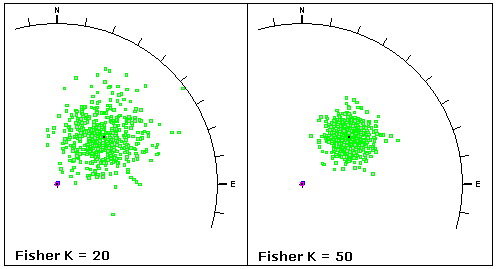Fisher Statistical Distribution
A Fisher Distribution is commonly used for modelling the distribution of 3-dimensional orientation vectors [Fisher (1953)], such as the distribution of joint orientations (pole vectors) on a sphere. A Fisher Distribution describes the angular distribution of orientations about a mean orientation vector and is symmetric about the mean. The probability density function can be expressed as:

(Eqn. 1)
where:
- θ = angular deviation from the mean vector
- K = "Fisher constant" or dispersion factor
In Dips, a Fisher distribution can be used to define probabilistic joint orientation.
Fisher K
The Fisher K value describes the tightness or dispersion of an orientation cluster. A larger K value (e.g., 50) implies a tighter cluster, and a smaller K value (e.g., 20) implies a more dispersed cluster, as shown in the following figure.
Effect of Fisher K on a randomly generated joint set of 500 samples

The Fisher K value can be estimated from Eqn. 2, for data sets with greater than approximately 30 vectors (poles) [Fisher (1953)].

(Eqn. 2)
where:
- N = the number of poles
- R = magnitude of the resultant vector (i.e. the magnitude of the vector sum of all pole vectors in the set).
Standard Deviation
By analogy with a Normal distribution, it can be shown that the standard deviation of a Fisher distribution can be estimated from Eqn.3 [Butler (1992)].

(Eqn. 3)
where:
- θ = angular deviation from the mean vector
- K = "Fisher constant" or dispersion factor